The Well
| « From Statiq to whatever | Cine18 ready to go » |
After the success of Home Body, we took another swing at a 48 Hour Film project, and it worked out great (if you ignore the fact that I only got five hours of sleep between Friday morning and Sunday evening)!
The film above is what we submitted to the 48 Hour Film Project other than the trivial additions of:
- some animal-related bloopers after the end credits
- a Grumpycorp Studios pre-roll replacing the 48-mandated pre-roll
This is the first 48 Hour Film project I've ever done where I felt that the delivered product is truly a finished product: The last time (Home Body), we lacked both a score and any sort of reasonable color grade, and this time I was fast enough to be able to do all of it by the deadline.
So, here's how it all went down. (Note: contains spoilers.)
Prep work
I'd been hoping to make this another family project but it turned out that the weekend of this 48 competition coincided with a family reunion in Mexico for most of my household. This meant that all we were left with in the house were me, Harry (the fifteen-year-old), five cats, one dog, and a lot of gear, yielding a two person / single adult team.
(I should mention that Harry just completed the Media Tech class in his freshman year of high school and is pretty stoked about filmmaking, so I'm definitely not roping him into this against his wishes.)
My aspiration rolling up to the weekend had been to create something dark and moody, ideally some sort of sci-fi thing, because moody lighting and haze are my bag, I've watched Dune a lot of late (with Harry), and it would support night shoots along with a generally sort of altered schedule. I'd also spent some time dorking around with granular synths for Home Body so a dark and moody score could be really dope.
Harry managed to recruit Marco (formally credited as "Katie" by their choice), a friend of ours from the high school's drama department. We found out the day before the competition started that Marco wouldn't get off work until ~3pm on Saturday, yielding a somewhat colorful three person / single adult team and cementing both a desire to do night shoots and an increasing sense of panic.
Friday, July 12th 2024
6:20pm (49 hours remaining)
The genre drawing begins. (Recall my desire for sci-fi and night shoots.) The card I pull:
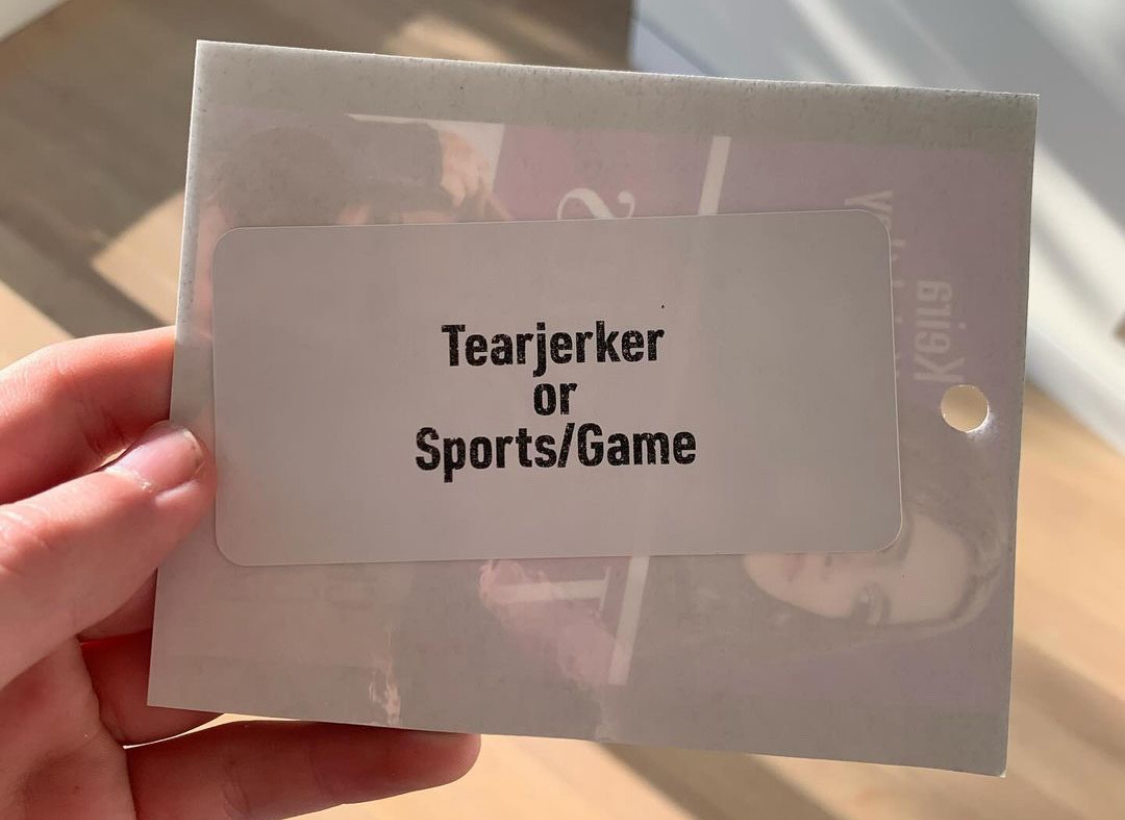
What am I even supposed to do with that?
As other teams draw their genres, I run a Google search on how broadly "Sports/Game" can be interpreted. Turns out, some team not only made a film about an in-office game of tag under the "Sports/Game" genre but also won some awards for it, so we decide we can interpret this a bit liberally (being vehemently anti-Sports people).
6:59pm (48.5 hours remaining)
The required elements are announced:
- Required character: Sam or Suzie French, coffee roaster
- Required prop: Pill bottle or pill container
- Required line: “Do us all a favor and stop talking.”
7:45pm (47.75 hours remaining)
We return home from the kickoff event, Marco arrives (I much prefer having actors around for the writing process), and Sarah joins us on Zoom from her hotel room in Mexico to toss around ideas.
8:30pm (47 hours remaining)
We pretty quickly coalesce on the spine of the story (a never-ending board game like Talisman supporting a sick kid). Because I live with a genius role-playing game developer, we own pretty much every RPG and board game in existence, including Talisman.
Harry has the brilliant idea of coming up with a musical theme in the score that he can then play on his guitar as the character during the film as mood music for the game, thus connecting the score into the action of the film (something something diegetic). We decide to allocate some time toward this adventure for Saturday morning since we have to wait for Marco to get off work at 3pm anyway.
Sarah has to log off because she's two timezones ahead, and we decide that we'll regroup at 7:30am her time / 5:30am my time to work on script and storyboards.
9pm (46.5 hours remaining)
Harry, Marco, and I start hauling gear from the grip truck to our living/dining/kitchen area in preparation for next day's shoot.

This turns out to be a brilliant move because starting a filming day by carrying heavy gear around is exhausting, especially for a three person team. Much better to deal with it the night before when, say, normal people might be writing their script, but somehow that's not us.
Midnight (43.5 hours remaining)
I spend a bunch of time in bed reading up on A/ the intellectual property rights requirements for items featured in a 48 Hour Film Project project and B/ publicly available role-playing game art that we could use for our endeavor without running afoul of A/. I don't really have a great solution.
Whatever time I spend in bed, most of it goes towards worrying and overthinking and I get around an hour or two of sleep. Yay.
Saturday, July 13th 2024
5:40am (38 hours remaining)
I start working on the script as Sarah starts developing storyboards.
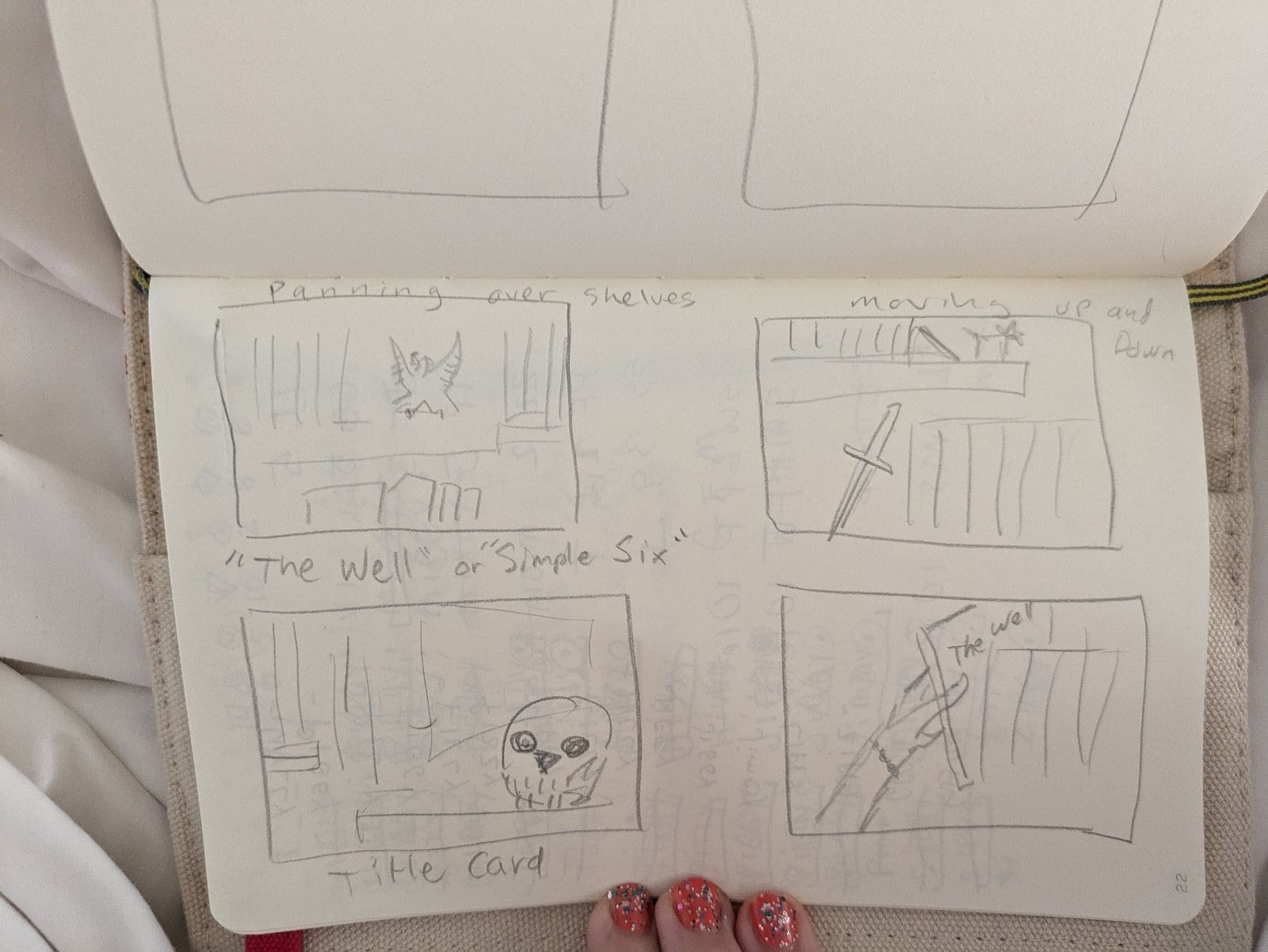
6:24am (37 hours remaining)
Sarah and I hop on Google Meet (Harry joins, too) to discuss details and more storyboard ideas.
We decide that rather than trying to greek out the artwork of a game like Talisman or manufacturing our own, we're just going to use our resident RPG developer's game, The Well, because he's willing to give us the rights to use the book, artwork, and text from it. I'm deeply grateful for this and you should totally buy his game - it's awesome.
7:10am (36.25 hours remaining)
I start writing down the script in WriterDuet. I really can't hype WriterDuet enough - it just works, it's really fast to use, and because it's cloud-based, collaboration is so dang easy.
9:16am (34.25 hours remaining)
I send the first draft of the script to Sarah and create a spreadsheet of the scenes and shots.
Harry and I start storyboarding in parallel with Sarah, organizing the scenes and shots in Milanote now that we have the order of things fairly locked down. (Milanote really is the perfect tool for this and worth every dollar.)
You can easily tell below which drawings are Sarah's and which are mine. However, it doesn't really matter how good or shitty the drawings are; what matters is that we have them.

We also transcribe the shot descriptions into the script so we don't have to reference too many different pieces of paper during the shoot - basically just the script (for words and details) and the shotlist (to check off everything we've shot).
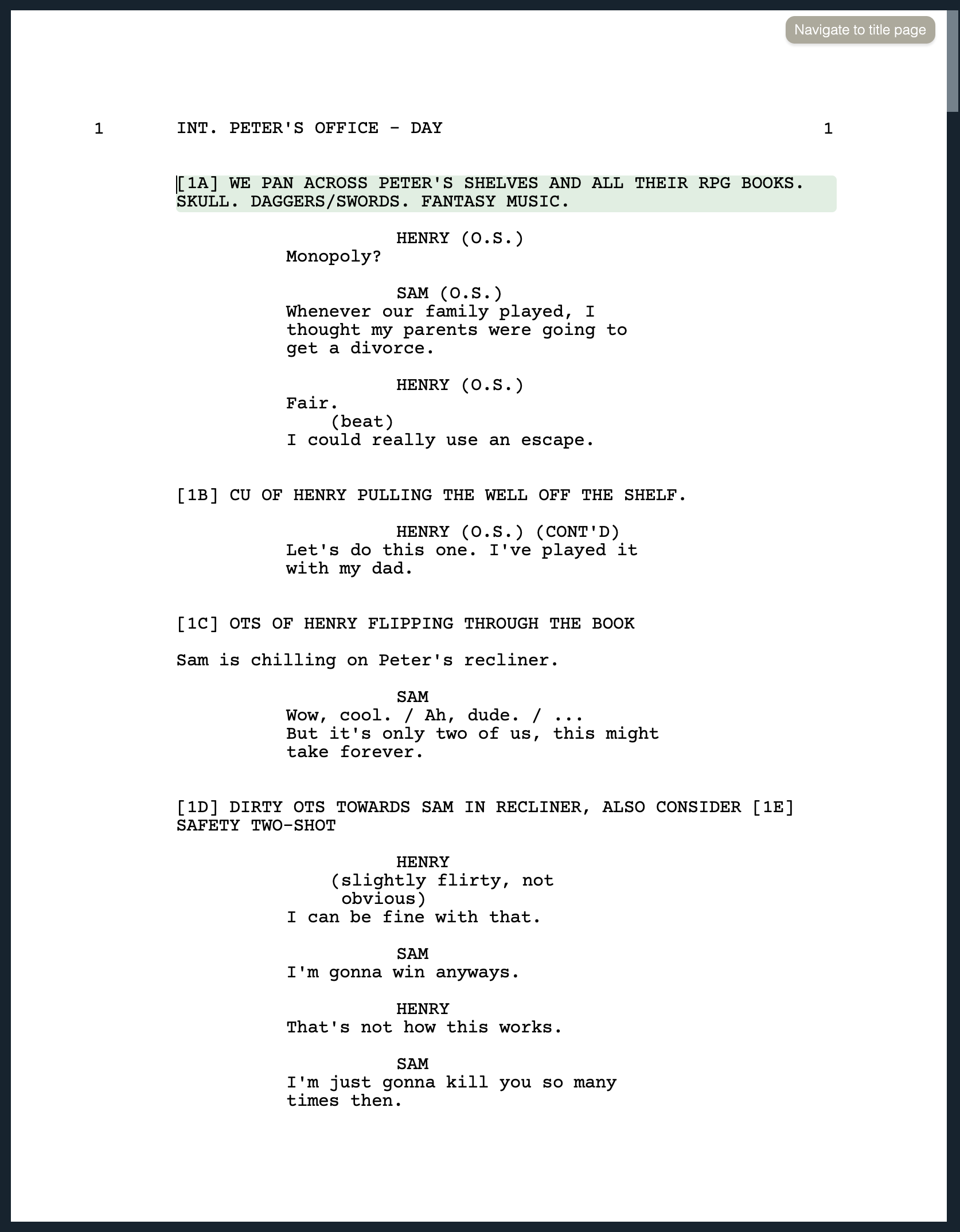
Does a real movie script look like this? No. Do I care? Also no.
11am (32.5 hours remaining)
Harry and I start messing around with the score. My beloved granular synths are not the right tool for this job, but thankfully I jumped on a sale of some ProjectSAM libraries last year and their Lumina library is pretty great for what we're aiming for.
Harry writes the theme he wants to use and we record it into Ableton (both the synth sequence as well as his acoustic guitar).
I set up an outdoor light that I know I will need at night. Setting it up during the daytime means I don't need to trip over massive light stands and cases in the dark.
Something always goes wrong and somehow the GFCI of the exterior outlet along that side of the house has decided it's on vacation. Thankfully I keep many 25' and 50' TRUE1 cables on the truck (most often used when I bring my moving lights to a theater) so within ten minutes, this problem is thankfully also dealt with and in such a way that if it should rain, I'm still fine. (Blessedly the later-generation Aputure lights are rain-tolerant.) (Also it doesn't rain all weekend; instead, it's unforgivingly hot as balls.)
1pm (30.5 hours remaining)
Sarah hops onto Google Meet one more time from the beach, but the connection is pretty terrible so we decide to call it good enough.
Harry and I set-decorate the house to get everything put in place for Marco's arrival. I'm happy about the sheer curtains and spring-tension shower curtain rod I anxiety-bought™ some weeks prior as they are coming in super-handy with one of the rooms we'll be filming in.
Sarah texts us various lines of game play banter for our characters. Will our actors actually deliver all of those lines? Not necessarily, but it's still really good to have a starting point.
3:30pm (28 hours remaining)
Marco gets here (with 4+ changes of clothes in hand for all the different story days we're filming, bless them) and we're off!

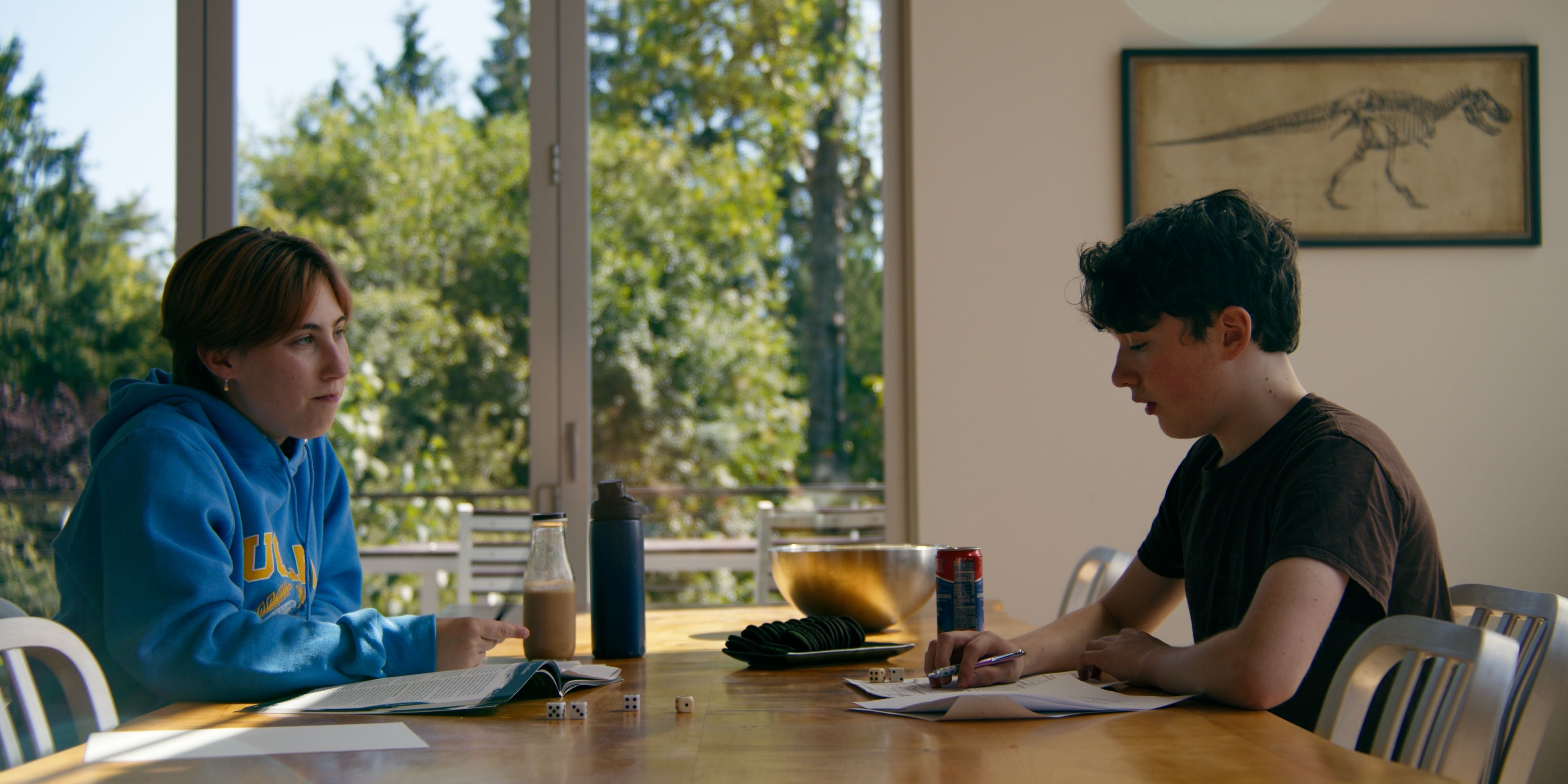
Let me take this moment for a quick detour to justify my continued gear acquisition anxiety.
I worked as a gaffer for my friend Raymond earlier this year and one of the very nice pieces of kit he had on set was a large wireless monitor (the SmallHD Cine18, to be precise).
What I observed on that shoot was that any actor or crew member who was able to see the monitor was instantly invested in the work: They got to see what the camera is seeing, were buoyed by how good the image looked, and could contribute set decoration and such as needed. In short, they were invested.
Any actor or crew member who was not able to see the monitor ended up staring at their phone or (far worse) ended up in random conversations that I personally found quite disruptive (though my brain does seem to get disrupted by words more than most).
And so I realized that the price of this piece of equipment should not be considered the price of the item itself, but should instead be viewed as the price of admission to having a fully bought-in and invested cast and crew.
So some months and a certain amount of financial ass-puckering later, here we are with a beautiful and exciting on-set image for all to see:

And it works! Best as I can tell, this instantly boosts our actors' confidence and makes me look like maybe I'm not a total clown.
5pm (26.5 hours remaining)
The film's story spans months (which in hindsight I highly recommend against for a 48), and Sarah has storyboarded a top-down dolly shot over the dining table as part of a montage suggesting said passage of time.
Is this a good use of time? I don't know. But! I had anxiety-bought™ the necessary ingredients for a double-goal-post DanaDolly setup a couple of years ago including all the necessary pipe and clamps and a hi-hat with which to undersling the fluid head on the dolly, so, like, might as well?
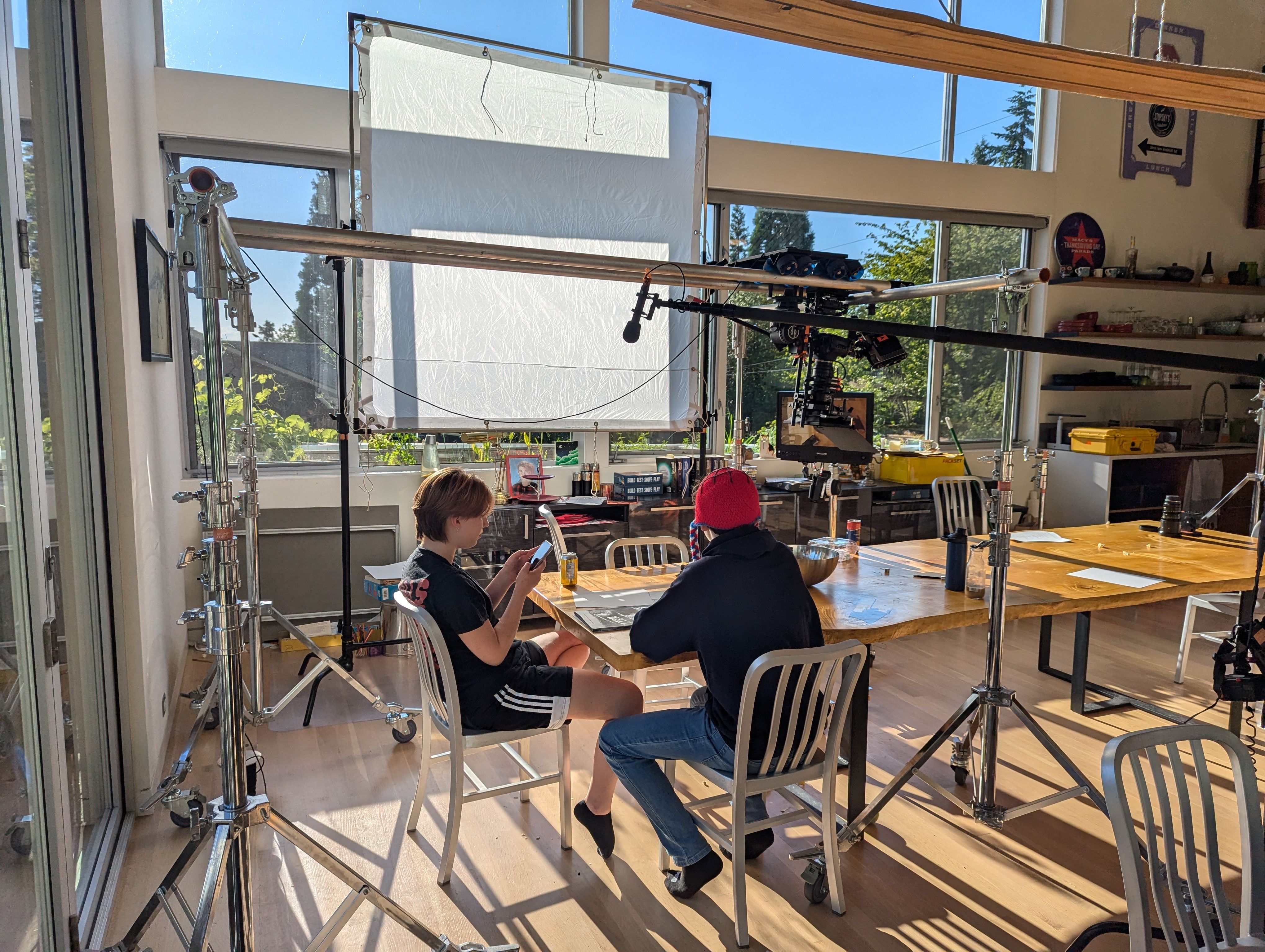
I run the dolly track at a bit of a downward slope so that I can pull it uphill at a fairly even rate using a long piece of tieline. (Why is tieline such a glorious theater product and hardly ever used on film sets? C'mon, film people, do more theater.)
Note also that the 6x6 full silk is the only lighting modifier I needed for this space - so much for "moody shots with fancy lights at night".
And just because I love this piece of kit so much, here's me yet again using the CamWok 5000 for an insert shot:
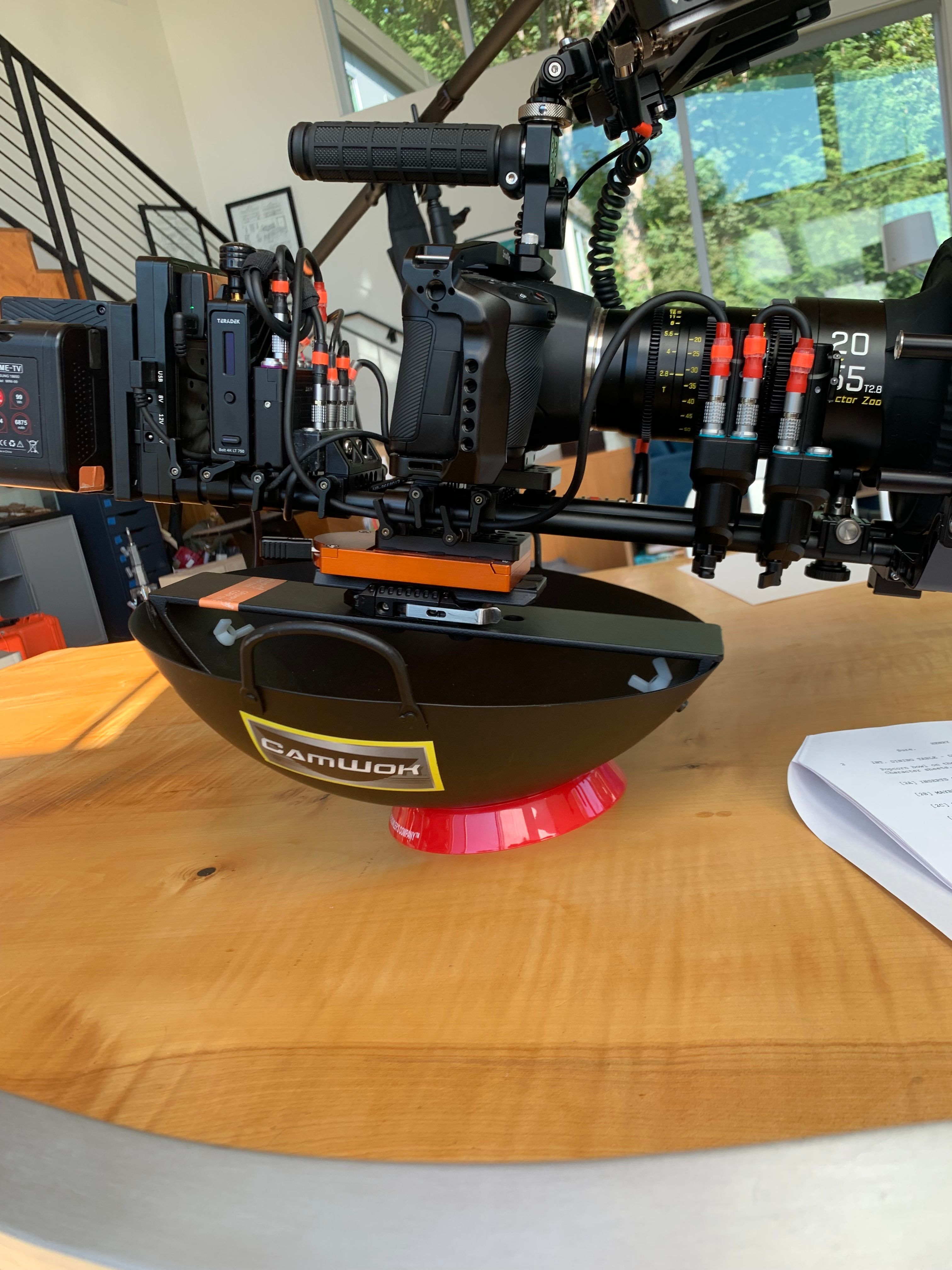
I can never entirely tell whether Dave makes these as a joke or for serious, but this thing has been seriously useful to me on most productions I've DP'd, so, can't argue with that.
6pm (25.5 hours remaining)
After we finish filming the scenes at the dining table, we move to the scenes on the living room couch.
We're now somewhat up against the clock because we've committed to a golden hour shot at a public waterfront dock on Mercer Island and will need to leave our house at ~7:30pm to make it on time for the sunset.
This of course is when my A camera decides it no longer wants to turn on. Good times. (In hindsight I suspect it overheated while facing downwards above the dining table.)
Good news: I have backups for every significant piece of equipment.
Not so good news: I've somewhat cheaped out on the backup / B-CAM camera, a Blackmagic Pocket 4K. It has some godforsaken speed booster / adapter from EF to MFT that I bought the cheaper version of many years ago and it has major focusing problems (i.e. its internal optics prevent me from focusing any further out than a few feet). It's also not compatible with the zoom lenses I've been using all day, which have been a major time saver compared to primes.
I had noticed this problem with the B-CAM at a different shoot in March, had read up on how to fix it, but had unfortunately not actually implemented the fix.
With the actors wondering why I look like I'm maybe losing my mind (which I am), I dial in the speed booster's backfocus just well enough, rotate through a couple of prime lenses to get the one I need for the shot, and off we go.
I suspect this speed booster is why those shots also look a bit different in terms of image quality and color, more so than I would have expected between the Blackmagic Pocket 6K (my A-CAM) and 4K (my B-CAM) themselves. Current score in favor of anxiety-buying™ better gear: two for two.
Thankfully, my A-CAM decides to turn back on after this grouping of setups.
8pm (23.5 hours remaining)
We've managed to squeeze in the hallway scene (more CamWok!) and head off to the dock.
As we set up to film I notice that I forgot my RBQ-to-Manfrotto adapter on the CamWok at home (another item I had saved money on by not buying a dedicated one for the CamWok → anxiety-buying™ intensifies / would have been justified), so I have to run home again (as the sun is setting) so I can put my camera on my tripod. Yay.
Here's what Harry and I location-scouted a week before the 48:

Here's what we film:
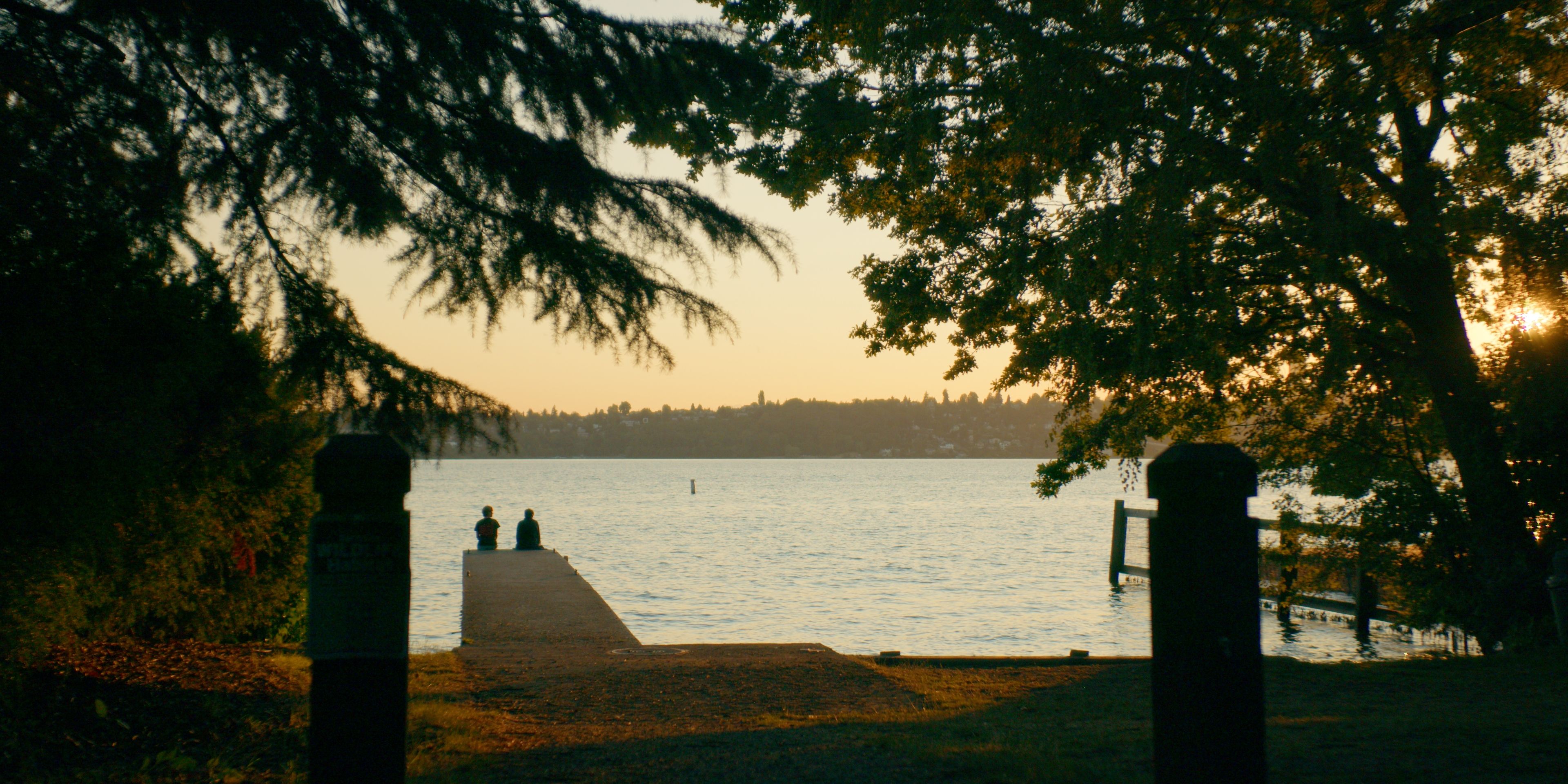
Many thanks to the random teens and adults who had gathered at the dock in anticipation of that evening's fireworks (wat - I hadn't known about that) who were super-pleasant about giving us ten minutes of private use of the space.
9pm (22.5 hours remaining)
Back at the house, we film our scenes in the entry area. Much like with Home Body, our last 48, we fake out daylight in the entry reasonably well.
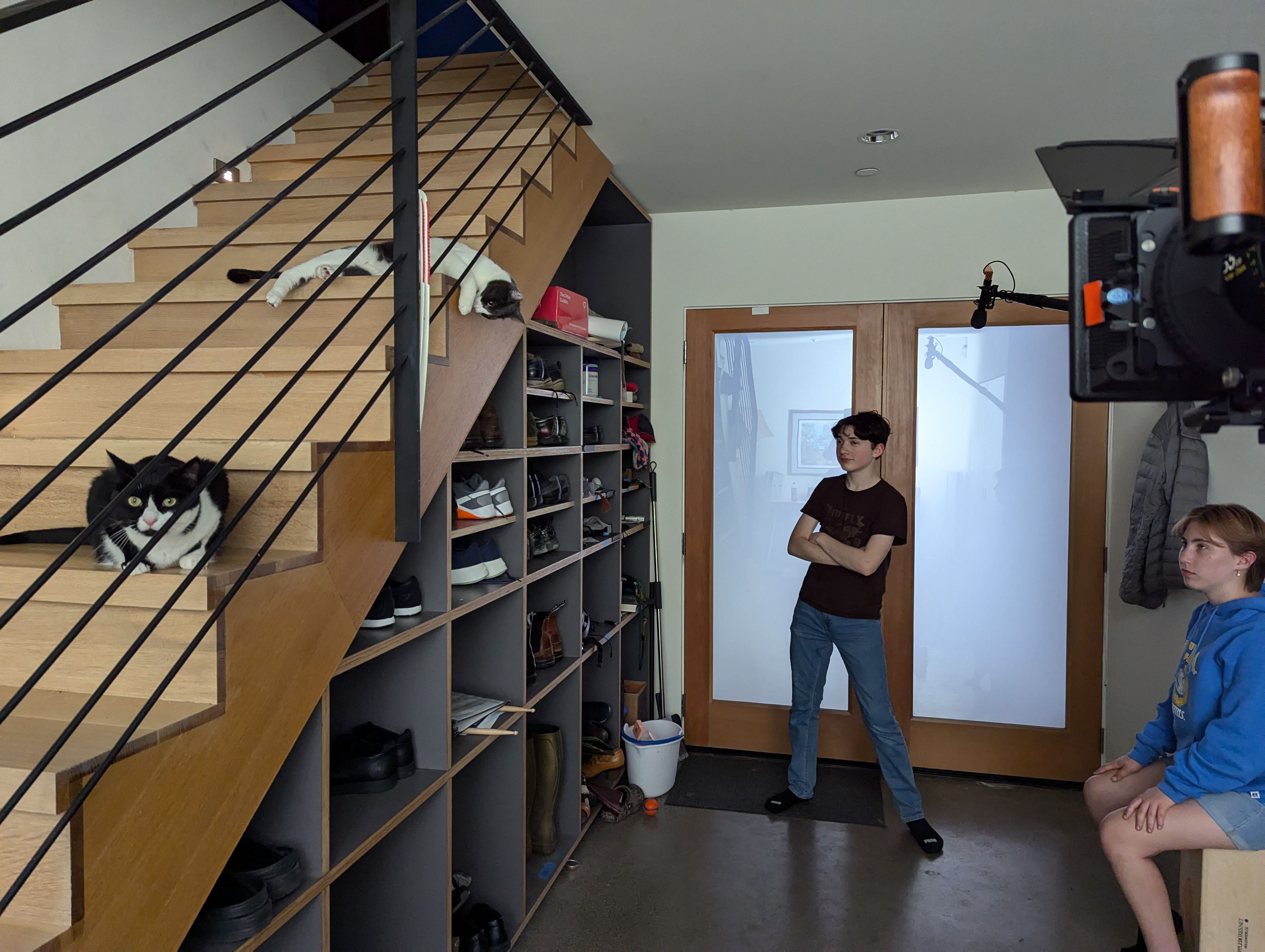
There's something about delineating the passage of time using a house's front door that's rather token but those frosted glass doors are just so pretty.
This is also where it comes in incredibly handy that Marco - playing the required character of Sam, a coffee roaster - actually does work at Starbucks and brought in their green apron for wardrobe. Please don't sue me, Starbucks.
10pm (21.5 hours remaining)
At this point we're filming the early morning scenes in Peter's office (the opening of the movie)...
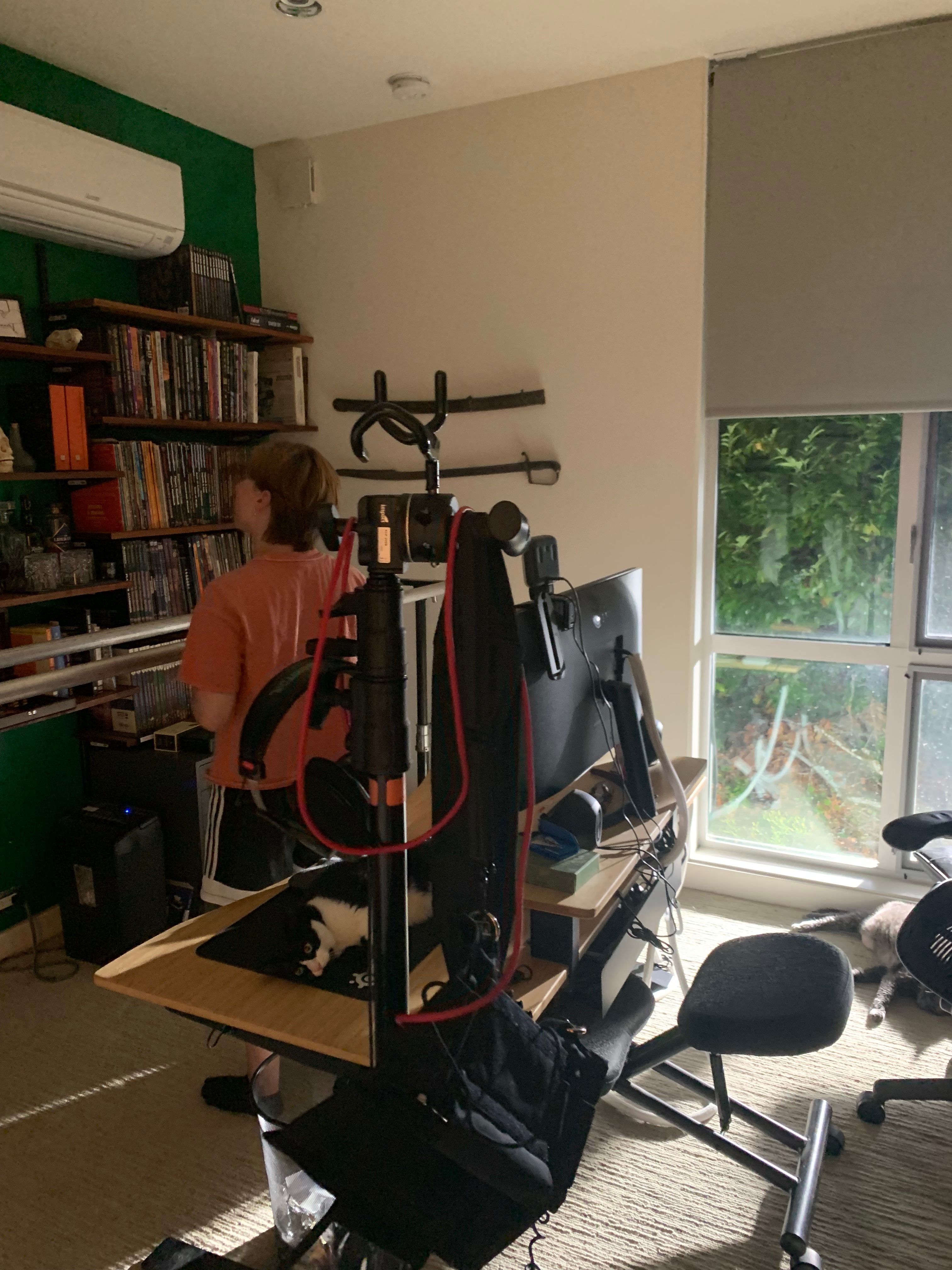
...except of course it is very much not morning so we fake it with a 1200W light outside:
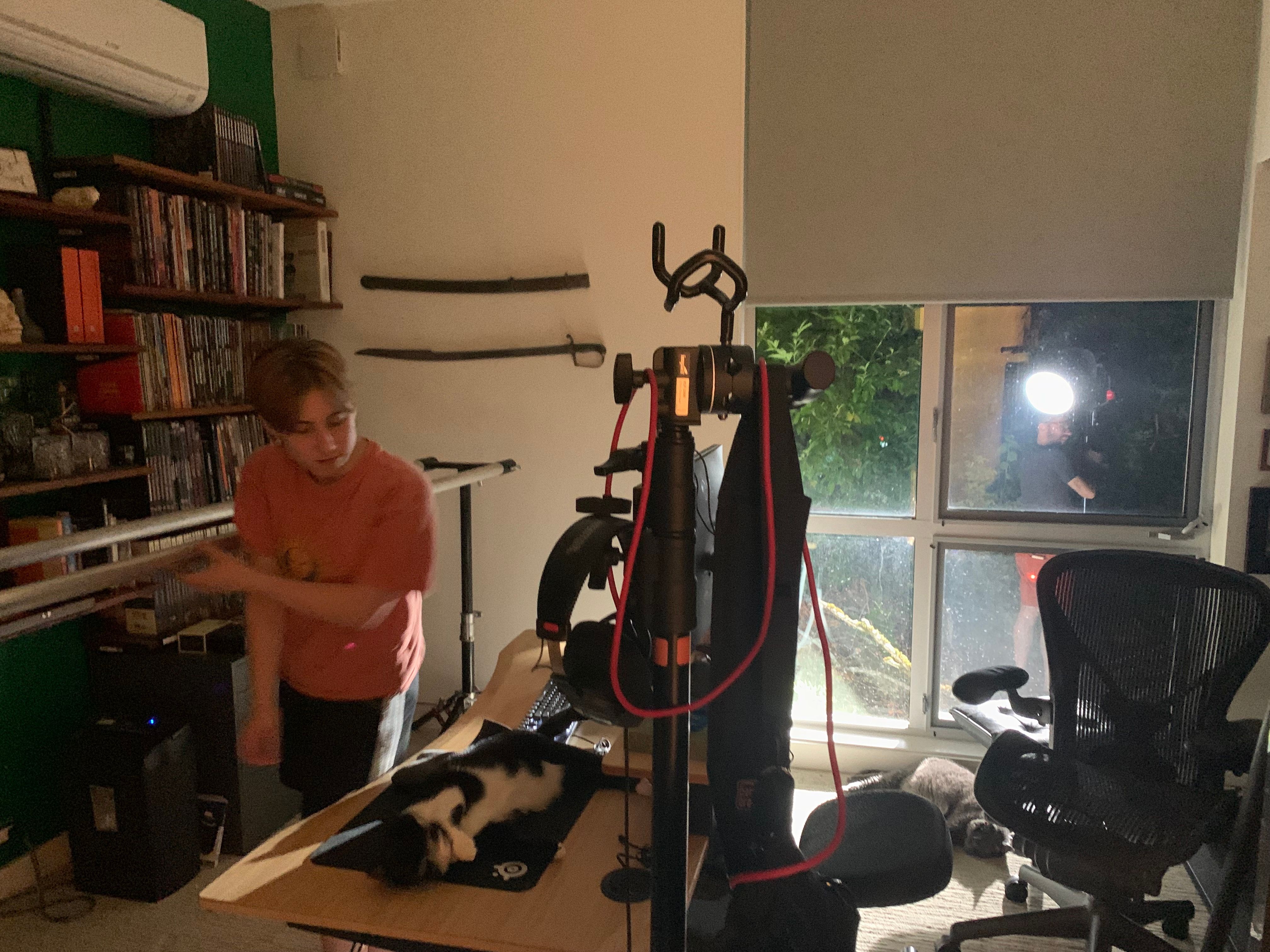
11:30pm (20 hours remaining)
Marco's parents would like Marco home because they've got work at 8am. Fair.
However, this does mean that we have not actually filmed the pivotal three scenes that end the movie. Whoops. My bad.
However-however, Marco is willing and able to be back at 11:30am the next day (my eternal gratitude) so we still have a chance to have a movie.
Sunday, July 14th 2024
12:30am (19 hours remaining)
I have offloaded all the media from the cameras, sound recorder, and lav recorders. Everything looks good, sounds good, and syncs up by timecode. Not all hope is lost.
1am (18.5 hours remaining)
Recall that the film's story spans months (still just as inadvisable as it was at 5pm).
Sarah had mentioned that we could use this flip book-style calendar we have in our entry to suggest the progression of time. She'd of course had something subtle in mind (like showing it in the montage sequences), but somehow my brain got this idea that I should show time passing with full-frame (more or less) dissolving shots of that calendar in a rather unsubtle way. Why? I don't know, I was tired.
So what better thing to do at 1am Sunday when we haven't even shot a complete film yet but get out my eMotimo motion control rig to precisely-ish traverse the camera in an arc past the calendar over and over as I flip the date between takes:
So I do this around twelve times, offload the footage, then stack the takes in Resolve, align them by when the motion starts, slice them into equal slices, and apply a three-frame "Smooth Cut" transition to blend the magic:
That composite timeline then gets chopped and retimed into the edit the next day later on this final day.
2:30am (17 hours remaining)
With all of this mischief managed, it's time for some sleep.
5:30am (14 hours remaining)
Wakey wakey, time to edit.
I label the shots, chop rolling takes into duration markers and give those labels, and rate them (green flag: good, purple flag: excellent, brown flag: well...).
Because we had a clear vision of the story, the shots, and what the edit was going to look like, putting together an initial cut is not particularly difficult. (Remember, kids, good preparation always pays off.) Starting from the selects, the whole thing pretty much just comes together with not a whole lot of surprises.
The montages are somewhat time-consuming to edit because there's a lot of material to select from but I expected that.
This is also a fine time to update my title / credit cards with the name of the film (The Well, however heavy-handed that may be). Fun fact: I make my title cards in PowerPoint. Easy .png export, Resolve easily updates the images on the timeline, off we go. This is not where we spend our time.
10am (9.5 hours remaining)
I have a workable cut of all the material we have so far, and Harry and I start to set up our final shooting location.
11:30am (8 hours remaining)
Marco arrives and we're immediately shooting again. The first thing I have the actors do is record wild lines for the lake-side scene because I'd captured that scene just with lavs and there was a lot of lake noise in them (like motorboats and such).
I want to take a moment here to thank Marco and Harry for all their work, and especially for all their wardrobe work. With the passage of narrative time, we keep going from outfit to outfit and not only do the two of them independently wrangle this for themselves, they also fully remember which story day has which outfit and what they need to do to keep continuity. So impressive.
We don't have enough space in the room for the Cine18 rolling monitor but the wireless director's monitor still allows Harry to participate in setting up the shot and set dressing. It's really nice having a co-DP for setting up shots and bouncing ideas around with rather than just keeping all the conversation bouncing about in my head.

Since the window faces north, we get pleasant but flat light. I supplement with the same 1200W outdoor unit we used the night before so we get some hard light edges that I tune using the sheer curtains and a floppy. A small light mat offers contrasting room tone and lets me dial in a bit more color temperature contrast.


Is this my best lighting ever? Definitely not. However, at this point it's nearly 2pm, I have five hours left to finish the movie, so it's a chop-chop type of mood.
2pm (5.5 hours remaining)
I repeat the earlier process of media offload, sync, selects, and rating. Just because time is running out isn't a reason to rush - if anything, the opposite.
3pm (4.5 hours remaining)
I'm done editing. Everything came together nicely. The only change from how I'd imagined I'd cut it is on the placement of the dice XCU shot: Marco's motion of sitting down cut together so nicely from the two angles that I don't want to cut away to the dice in the middle of it. My natural preference is towards letting shots play instead of cutting anyhow.
It's time for an audio pass, selecting lavs versus boom for each scene and then cleaning clips in RX to remove reverb and A/C noise (c.f. the earlier "it's unforgivingly hot as balls all weekend long" == "continuous A/C noise"). My recent upgrade of my lavs (COS11d) and boom (MKH50) means that the sound quality is already about as good as I need it to be for a 48 without a lot of manipulation (it's not anxiety if it's justified, just sayin'). Dialog compressor + EQ on the bus, done.
Good news: The poor-person's-ADR I recorded for the lake-side scene is really useful in making that scene not sound like ass.
Less good news: I chopped/ADR'd the takes first, then processed them in RX, and I could have saved myself a bunch of RX'ing time if I had reversed that order. A lesson for next time.
4pm (3.5 hours remaining)
Time for color. Some years back I invested in the Davinci Resolve MicroPanel and all the physical wheels, balls, and buttons are just a huge timesaver. I've watched and journaled most of Cullen Kelly's and Darren Mostyn's YouTube channels so I at least kind of know what I'm doing and I have a good recipe to follow.
Every shot gets a happy little node tree with exposure, contrast, balance, and saturation managed step by step.

A few shots get put into groups for group-level tuning but this is all pretty much getting only a single pass anyhow (there isn't the time to do more), so I don't need to get precious about it.
At the timeline level, the project gets sweetened with a few subtler picks from Cullen Kelly's Voyager LUT Pack, with Corvus for a tone base, Alcor for a tone modifier, and Eris for a palette foundation.
It's really not doing a lot:
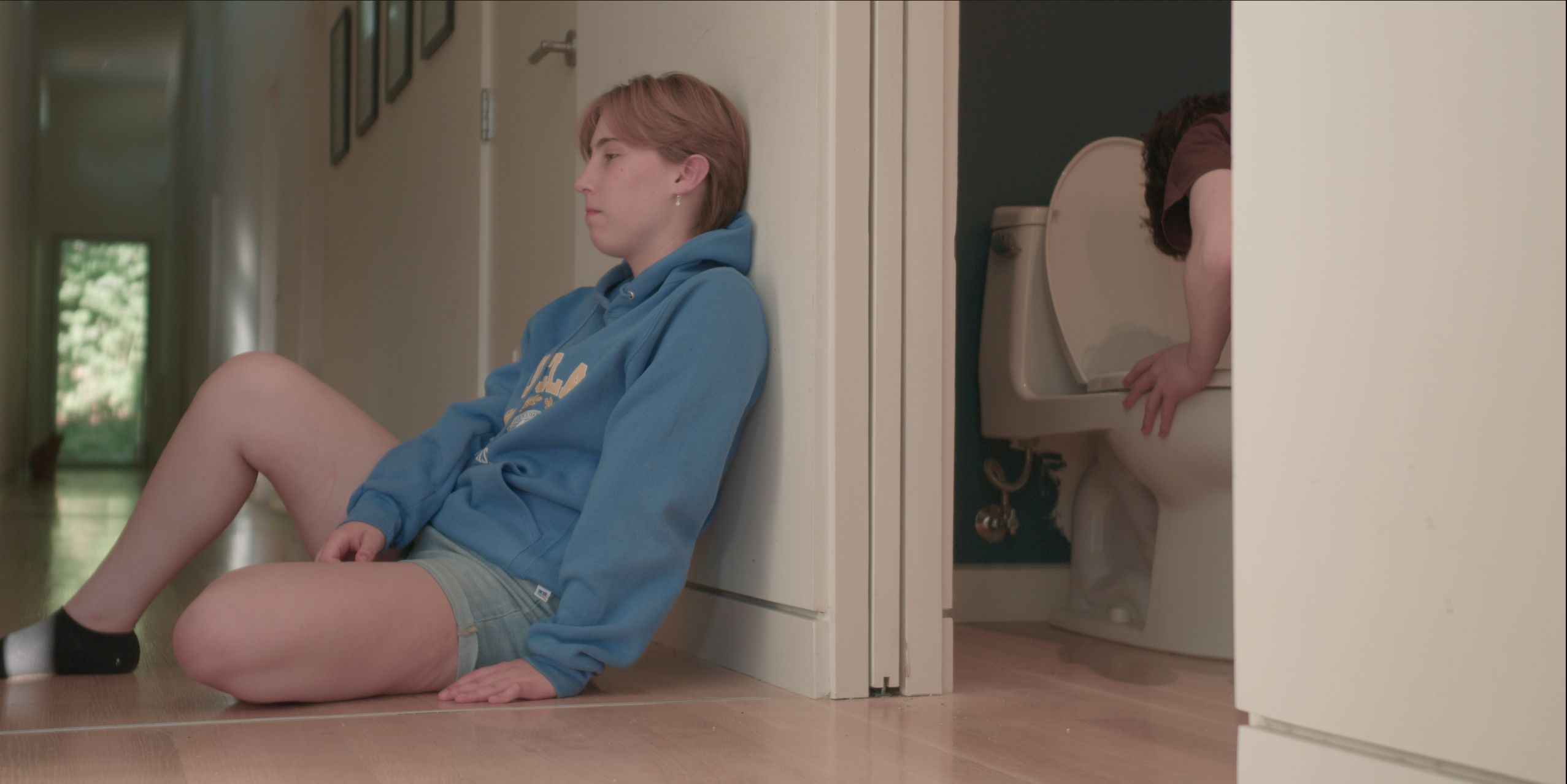
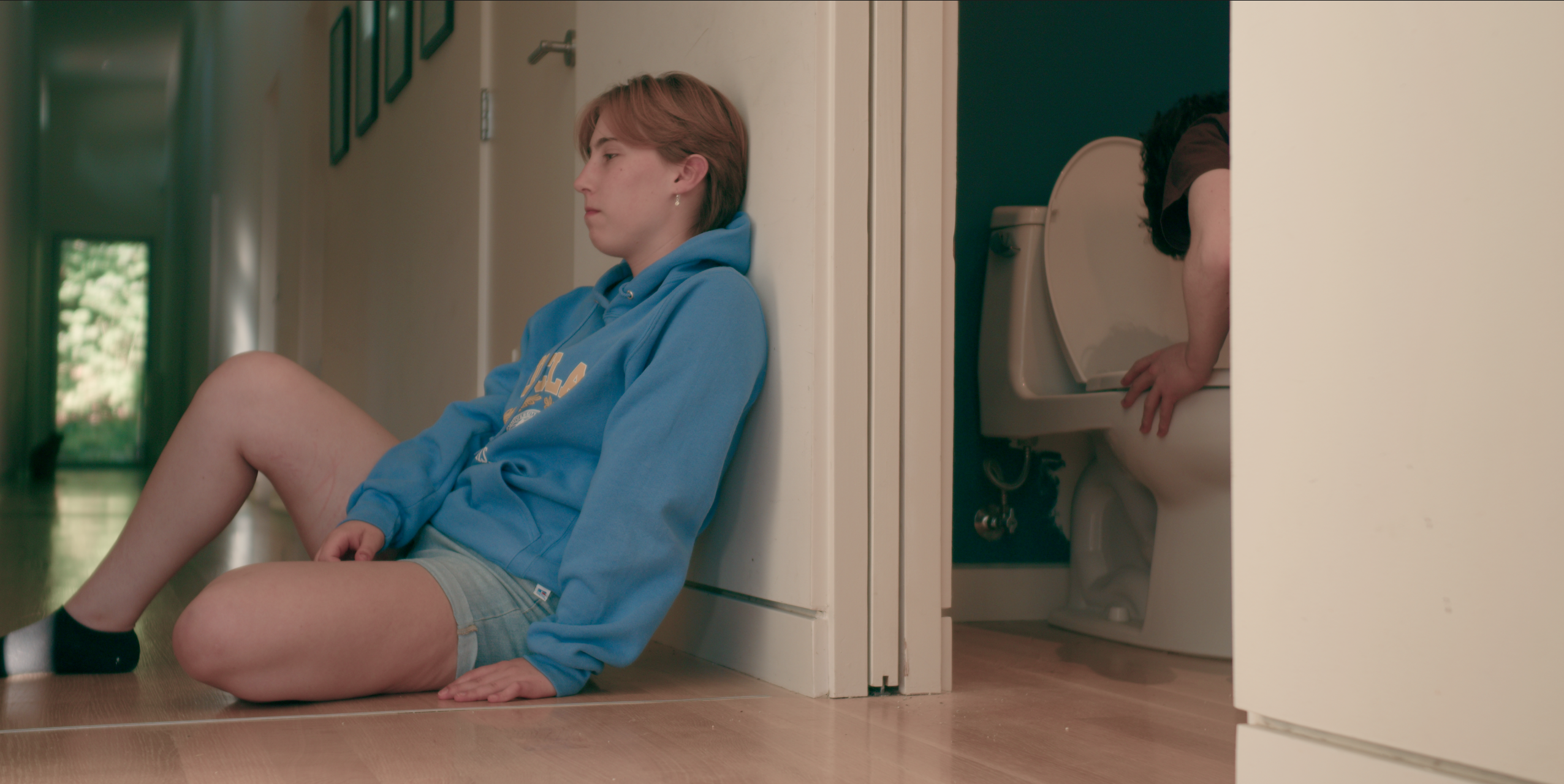
...but it adds some subtle interest.
I'm generally not a fan of the slaps some LUTs on it approach to color grading; I'd rather understand every transformation that's happening (like with the PixelTools Film Lab collection of node trees), but there's only so much time remaining.
5:30pm (2 hours remaining)
Time to write (finish?) the score. I chuck an export of the video into Ableton and Harry and I get to work stacking up our synths against the picture-locked video.
The ProjectSAM synths are being cumbersome because their patterns don't align against any sort of click. We have to keep adjusting by ear and trial-and-error. Less in love with them now than I was just a day prior. I should probably read the manual.
6:55pm (35 minutes remaining)
We do a final export of the score from Ableton, re-ingest that into Resolve, and run our first "probably good enough" export from Resolve.
Thankfully the Mac Pro I anxiety-bought™ after my PC kept crashing during the last 48 is capable of rendering in faster-than-real-time even with the color grade and the goofy delivery codec (H.265), allowing us to make another tweak or two on music versus dialog leveling.
7:13pm (17 minutes remaining)
The final render completes as I fill out the wrap-up paperwork. (So much paperwork to manage for these...)
7:20pm (10 minutes remaining)
The final render has been uploaded, all time-critical paperwork is done - that's it! Ten minutes to spare.
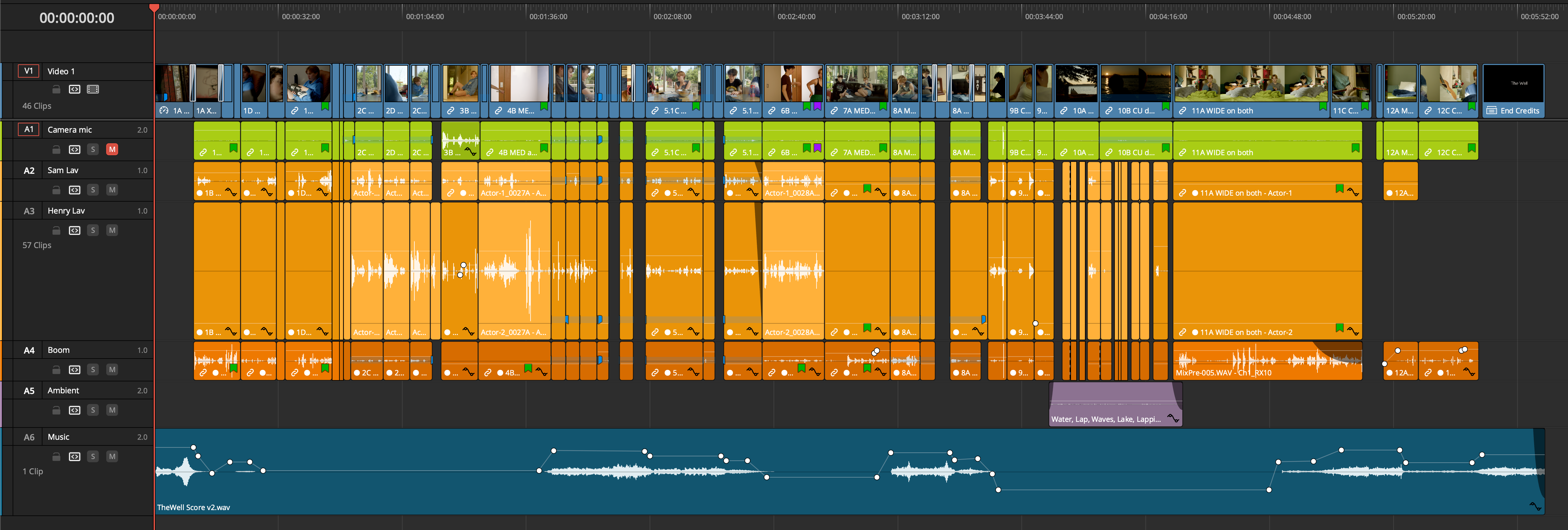
10pm
Peter, Sarah, and the rest of the family come home. I get the signatures I need from them for the final bits of paperwork, upload the paperwork, and finally go to sleep.
It's a wrap
This was an equal parts amazing and terrifying experience. During the experience itself, it was largely terrifying (even if I managed to hide my panic and worry from those around me well). Afterwards, though, I'm just amazed that we pulled this off.
I reckon there are few teams with just a single grown-up on site. I follow lots of local filmmakers on Instagram and they were all participating (we had around eighty teams this year!), many of them with 10+ person crews, some of them renting a giant studio space at Harbor Island Studios, and one of them even had a dude with an Arri Trinity rig (how the even). I'm sure their work came out looking much higher-end but that doesn't make me any less happy with what we were able to create.
Would I do this again? Maybe. Definitely, actually, if I didn't also have people reviews happening at work on the days bracketing the 48, as well as having to prep for this ridiculous Nickelback burlesque show that I'm playing drums for (but that's a story for another day). I didn't have any option in this scheduling, only the option to try or not try, and I'm just so glad we tried.
I'm really proud of the kids? teens? nearly-adults, some of them more than others? and what all they achieved, and I'm really happy that the many months of preparing I've done (be it on choosing gear, researching color grading techniques, etc.) worked out exactly as I'd wanted it to.
Most of all I'm happy that I can consider this project complete - there's nothing I still want to finish about it, nothing hanging over my head, and that feels really good right now.
Appendix: Some process notes
On (not) slating
All my gear (cameras, sound recorder, and TrackE lav recorders) is time-coded so I don't need to rely on any slating to align sound with video.
This time I made the somewhat adventurous decision to A/ not slate anything at all, not even recording metadata in the camera, and B/ to just do rolling takes for every setup instead of stopping and re-starting.
I was really happy with how this worked out both during filming and in the edit. I easily saved myself a half hour during the day not dealing with slates or take starts/stops (since I'm a one-person band having to roll the camera, the sound recorder, and the lavs), allowing me to be more present with the actors and coaching them through the performances instead of having to constantly put my technician hat back on.
During the edit, I just used duration markers in Resolve to call out good/best takes within each clip and it was just as easy to work with as separate takes.
Would I recommend this for a more rigorous/lower-pressure show? Maybe not? But for my own work moving forward (whenever I'm running both the set and post), this is making me happy. The only exception to this would be tracking lens data for gyro-based motion stabilization.
On having a script
For our last 48 (Home Body) we just storyboarded, we didn't even write a script, and just improvised the lines on set based on knowing what beats we wanted to hit.
I think that was a fine choice, but I'm also glad that we did have a script for this one.
I was very open with the actors that the script was just a starting point and we could modify and re-work things on the fly if they didn't feel right. We took advantage of that on several occasions and it absolutely made the film better.
On having storyboards
I cannot overstate how valuable storyboards are, especially with such a limited crew on site (i.e. me, and Harry's brain for shot composition as well).
When I'm framing and lighting a shot, it's incredibly valuable that I don't need to second-guess whether this is the right shot, whether I'm going to use it or not (and where), and whether I might need other shots. I have neither the time nor the emotional energy for it.
Just like with Home Body, the storyboards were the shot list, were the edit. It all just came together from the storyboards. No setup or shot was wasted.
I've worked on enough other projects (from/with/for other people) without storyboards that I'm pretty much going to refuse working on non-storyboarded shows from now on. It's just not a good use of time if we don't invest that level of intentionality and foresight in pre-production.
| « From Statiq to whatever | Cine18 ready to go » |